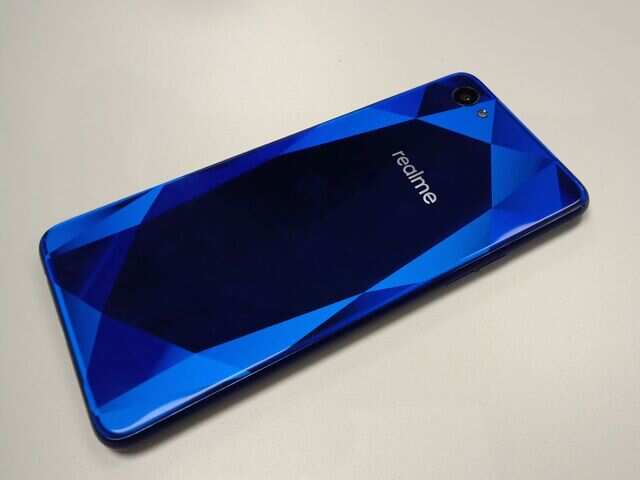Realme 1 price, specifications, features
According to Oppo, its new Realme sub-brand has been conceived with the Indian youth in mind. Realme smartphones will be priced between Rs. 10,000 To Rs. 13,000. With the new Realme 1, Oppo plans to take on Xiaomi's might in the budget smartphone segment.
The Realme 1 starts at just Rs. 8,990 and has an 18:9 display, up to 6GB of RAM, a fibreglass body with a unique design, and Android 8.1 Oreo out of the box
Design
The Realme 1 has a fibreglass body with a glossy diamond-cut effect on the back. Oppo says that there are 15 tangent planes carved onto the back panel to reflect light in different ways and make the smartphone "look like a diamond". While the design is definitely unique and snazzy, it might come across as a bit ostentatious and gaudy to some. One problem with the fibreglass material is that it gets smudged with fingerprints extremely easily.
Thanks to the impressive 84.75 percent screen-to-body ratio, the Realme 1 is very compact and pocketable.The screen is not exactly borderless but the front of this phone does look sleek and modern. Despite the frame being made of plastic, the build quality is top-notch. We dropped the Realme 1 numerous time during our review period and it did not suffer any significant damage.
The rear camera module on the Realme 1 barely protrudes from the chassis. The left of the smartphone has the volume rocker which is ergonomically placed and easy to use. The power button and the SIM tray are on the right. While many models in this price range have hybrid dual-SIM trays, the Realme 1 has dedicated slots for two Nano-SIMs and a microSD card.
Realme 1 performance, software, and battery life
During our review period, the 6GB RAM variant of the smartphone handled everything we threw at it with aplomb - from basic day-to-day tasks such as taking pictures, browsing the Web, using social media applications, and watching videos, to intensive workloads like recording videos in full-HD. It even handled both casual games like Subway Surfers and heavy titles like Asphalt 8 without any dropped frames or stutters. The Realme 1 did not get too warm when when pushed.
Oppo claims that the Helio P60 outperforms the Qualcomm Snapdragon 636 in the AnTuTu benchmark. To put that claim to the test, we ran the benchmark for ourselves. The Realme 1 managed an impressive 138,326 points in AnTuTu. The more expensive Redmi Note 5 Pro, which is powered by the Qualcomm Snapdragon 636 processor, managed a score of 105,369 in comparison.
Other benchmark scores were equally impressive. The Realme 1 managed 38fps in GFXbench T-Rex, and12fps in the more demanding GFX Bench Manhattan 3.1 graphics tests. It also gave us scores of 8,009 in PC Mark Work 2.0, and 1,513 and 5,795 respectively in Geekbench's single- and multi-core tests
The Realme 1 runs Oppo's highly modified Color OS 5.0 on top of Android 8.1 Oreo. While animations are snappy and the interface is fluid, it is extremely cluttered and in dire need of simplification. The Settings app and quick launch panel in particular are quite hard to navigate around.
There is no app drawer, and the Google Now panel has been replaced by a custom screen that displays the weather, steps taken, favourite contacts, and recent events. On a positive note, third-party bloat is minimal. There are also a host of nifty features, such as dual apps, a three-finger screenshot shortcut, a theming app, and lockscreen gestures. There is no information as of now regarding plans for an Android P update.
Battery life is quite impressive. In our HD video loop battery test, the smartphone lasted 11 hours and 30 minutes. In terms of real-world performance, we never found ourselves reaching for the charger before midnight after having used the phone quite heavily all day. The Realme 1 does not support quick charging though, and a full charge takes around 2.5 to 3 hours, which is average at best
Realme 1 cameras
On the imaging front, the Realme 1 has a 13-megapixel rear camera with a single-LED flash, and an 8-megapixel front camera. The company claims that it can recognise 296 facial points, and that artificial intelligence features are baked in.
The iOS-like camera app is easy to use and offers a wide variety of modes such as Panorama, Time-lapse, and AR sticker. There is a fully featured Pro mode as well, which allows you to alter the shutter speed, ISO, exposure, aperture, and white balance.
The AI based selfie camera automatically detects skin tone, skin type, age, and gender, and optimises image settings accordingly. Oppo claims that it has eight million beauty reference points in its database. In our experience, the front camera produced decent photos in well-lit scenarios but struggled in low light. The AI beautification really softened facial features and added an unpleasant watercolour-like effect.
Both the rear and front camera are capable of capturing bokeh shots using software algorithms. The resultant images are nothing to write home about, with poor edge detection and details.
The 13-megapixel rear camera features AI-based scene recognition which allows it to optimise settings for different scenes and objects in real-time. It pulls in a decent amount of detail but images look slightly dull. The sensor has poor dynamic range and struggles with detail and auto-focus in low light. Video recording maxes out at 1080p for both the front and rear cameras. Videos are good enough for social media use but lack detail and are not stabilised.
| LAUNCH | Announced | 2018, May |
|---|---|---|
| BODY | Dimensions | 156.5 x 75.2 x 7.8 mm (6.16 x 2.96 x 0.31 in) |
|---|---|---|
| Weight | 155 g (5.47 oz) | |
| SIM | Dual SIM (Nano-SIM, dual stand-by) |
| DISPLAY | Type | IPS LCD capacitive touchscreen, 16M colors |
|---|---|---|
| Size | 6.0 inches, 92.9 cm2 (~78.9% screen-to-body ratio) | |
| Resolution | 1080 x 2160 pixels, 18:9 ratio (~402 ppi density) | |
| Multitouch | Yes | |
| - ColorOS 5.0 |
| PLATFORM | OS | Android 8.1 (Oreo) |
|---|---|---|
| Chipset | Mediatek MT6771 Helio P60 | |
| CPU | Octa-core (4x2.0 GHz Cortex-A73 & 4x2.0 GHz Cortex-A53) | |
| GPU | Mali-G72 MP3 |
| MEMORY | Card slot | microSD, up to 256 GB (dedicated slot) |
|---|---|---|
| Internal | 128 GB, 6 GB RAM or 64 GB, 4 GB RAM or 32 GB, 3 GB RAM |
| CAMERA | Primary | 13 MP (f/2.2), phase detection autofocus, LED flash |
|---|---|---|
| Features | Geo-tagging, touch focus, face detection, HDR, panorama | |
| Video | 1080p@30fps | |
| Secondary | 8 MP (f/2.2) |
| SOUND | Alert types | Vibration; MP3, WAV ringtones |
|---|---|---|
| Loudspeaker | Yes | |
| 3.5mm jack | Yes | |
| - Active noise cancellation with dedicated mic |
| COMMS | WLAN | Wi-Fi 802.11 b/g/n, WiFi Direct, hotspot |
|---|---|---|
| Bluetooth | 4.2, A2DP, LE | |
| GPS | Yes, with A-GPS | |
| Radio | FM radio | |
| USB | microUSB 2.0, USB On-The-Go |
| FEATURES | Sensors | Accelerometer, gyro, proximity, compass |
|---|---|---|
| Messaging | SMS(threaded view), MMS, Email, Push Email | |
| Browser | HTML5 | |
| - MP4/H.264 player - MP3/WAV/eAAC+/FLAC player - Document viewer - Photo/video editor |
| BATTERY | Non-removable Li-Ion 3410 mAh battery |
|---|
| MISC | Colors | Diamond Black, Solar Red, Moonlight Silver |
|---|---|---|
| Price | About 9000 INR |
| TESTS | Performance | Basemark OS II: 2031 / Basemark OS II 2.0: 1940 Basemark X: 10880 |
|---|---|---|
| Display | Contrast ratio: 1209 (nominal), 2.932 (sunlight) | |
| Camera | Photo / Video | |
| Loudspeaker | Voice 64dB / Noise 70dB / Ring 89dB | |
| Audio quality | Noise -89.0dB / Crosstalk -87.3dB |







0 Comments